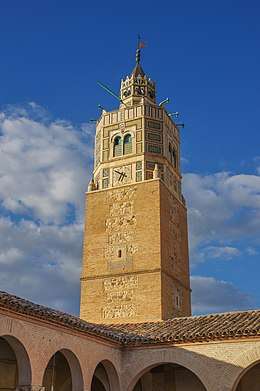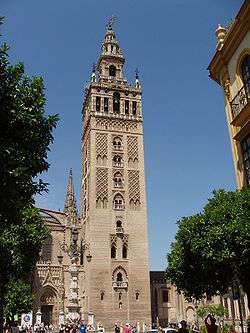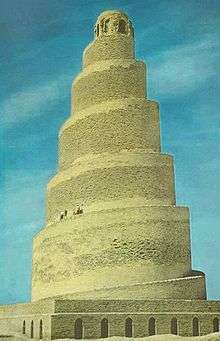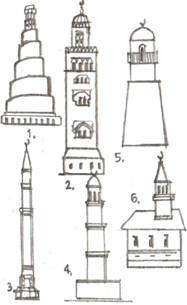Minaret

 |
| Part of a series on |
| Islamic culture |
|---|
| Architecture |
| Art |
| Dress |
| Holidays |
| Literature |
| Music |
| Theatre |
|
Minaret (/ˌmɪnəˈrɛt,
Functions
The purpose of minarets in traditional Eastern region architecture is to serve as a ventilation system for a building in very hot climates of the building that would (hypothetically) have an opening in the ceiling that would both accumulate and allow warm air to leave the building through a cupola.[4] That buildings of middle eastern origins have such outstanding features is architecturally intentional. Mosques usually have a center hall room with a raised ceiling or dome to allow for heat to accumulate and rise upwards leaving the cold air on the lower floor allowing for a system of natural air conditioning.
However, in modern times, with the invention of the modern air conditioning, the purpose of minarets has changed to that of a traditional symbol. The minaret would be equipped with a speaker that would call people to prayers in Muslim countries. In addition to providing a visual cue to a Muslim community, the main function at present is to provide a vantage point from which the call to prayer, or adhan, is made. The call to prayer is issued five times each day: dawn, noon, mid-afternoon, sunset, and night. In most modern mosques, the adhān is called from the musallah (prayer hall) via microphone to a speaker system on the minaret.
History

The earliest mosques lacked minarets, and the call to prayer was performed elsewhere;[6][7] hadiths relay that the Muslim community of Medina gave the call to prayer from the roof of the house of Muhammad, which doubled as a place for prayer. Around 80 years after Muhammad's death, the first known minarets appeared.[8]
Minarets have had various forms (in general round, squared, spiral or octagonal) in light of their architectural function.
The number of minarets by mosques is not fixed: at origin, one minaret would accompany each mosque, then the builder would construct several more. The reasons for that mainly revolve around esthetics, symmetry, the will to punctuate a strong architectural feature, as well as assure the stability of the design.
For centuries, the Great Mosque of Mecca was the only one to have six minarets. However, when the Ottomans built the Blue Mosque of Istanbul, it was given six minarets. A seventh minaret had to be constructed in Mecca in order for the Sacred Mosque not to be surpassed. Nevertheless, the call to prayer is usually done from one minaret.
Minarets have been described as the "gate from heaven and earth", and as the Arabic language letter aleph (which is a straight vertical line).[9]
In the Maghreb, the oldest minaret is that of the Great Mosque of Kairouan in Tunisia. The oldest minaret still standing of all the Muslim world and consequently the oldest minaret in the world.[5][10] The construction of the Great Mosque of Kairouan, probably commenced at the beginning of the 8th century, date of its actual state of the first half (9th century, towards 836) according to the opinion of most archeologists.[11] Constituted by three levels of decreasing widths reaching sizes of 31.5 meters, and being distinguished by an aspect both massif and majestic, this Great Mosque is considered as the prototype of Minarets in the Western Muslim World.[11]
Many mosques were established in former houses of worship of other faiths, notably around the Mediterranean. Accordingly, when a church was transformed into a mosque, the bell tower would transformed into a minaret. Similarly, when the former cathedral became the Almohad Mosque in Seville, and then became again the Seville Cathedral, the minaret of Giralda became a bell tower. This was a typical style transformation of a place of worship.

The tallest minaret, at 210 metres (689 ft), is located at the Hassan II Mosque in Casablanca, Morocco. In some of the oldest mosques, such as the Great Mosque of Damascus, minarets originally served as illuminated watchtowers (hence the derivation of the word from the Arabic nur, meaning "light").
Construction
The basic form of minarets consists of three parts: a base, shaft, and a gallery. For the base, the ground is excavated until a hard foundation is reached. Gravel and other supporting materials may be used as a foundation; it is unusual for the minaret to be built directly upon ground-level soil. Minarets may be conical (tapering), square, cylindrical, or polygonal (faceted). Stairs circle the shaft in a counter-clockwise fashion, providing necessary structural support to the highly elongated shaft. The gallery is a balcony that encircles the upper sections from which the muezzin may give the call to prayer. It is covered by a roof-like canopy and adorned with ornamentation, such as decorative brick and tile work, cornices, arches and inscriptions, with the transition from the shaft to the gallery typically sporting muqarnas.
Local styles
Styles and architecture can vary widely according to region and time period. Here are a few styles and the localities from which they derive:
_(14594614317).jpg)

- Tunisia
- (7th century) Quadrangular, the Mosque of Uqba of Kairouan has the oldest minaret in the Muslim world.
- Turkish (11th century)
- 1, 2, 4 or 6 minarets related to the size of the mosque. Slim, circular minarets of equal cross-section are common.
- Egypt (7th century) / Syria (until 13th century)
- Low square towers sitting at the four corners of the mosque.
- Iraq
- For a free-standing conical minaret surrounded by a spiral staircase, see Malwiya.
- Egypt (15th century)
- Octagonal. Two balconies, the upper smaller than the lower, projecting mukarnas, surmounted by an elongated finial.
- Persia (Iran) (17th century)
- Generally two pairs of slim, blue tile-clad towers flanking the mosque entrance, terminating in covered balconies.
- Tatar (18th century)
- Tatar mosque: A sole minaret, located at the centre of a gabled roof.
- Morocco
- Typically, a single square minaret; notable exceptions include a few octagonal minarets in northern cities - Chefchaouen, Tetouan, Rabat, Ouezzane, Asilah, and Tangier - and the round minaret of Moulay Idriss.
- South Asia
- Octagonal, generally three balconied, with the upper most roofed by an onion dome and topped by a small finial.
See also
References
- ↑ "minaret". Random House Webster's Unabridged Dictionary.
- ↑ "minaret." Online Etymology Dictionary. Douglas Harper, Historian. 21 Mar. 2009.
- ↑ Altunişik, A.C. (20 July 2011). "Dynamic response of masonry minarets strengthened with Fiber Reinforced Polymer (FRP) composites" (PDF). Natural Hazards and Earth System Sciences. 11. doi:10.5194/nhess-11-2011-2011.
- ↑ Imam, S M Najmul (December 2003). Ventilation in a Mosque – an Additional Purpose the Minarets May Serve. The 7th International Conference - Healthy Buildings 2003. Singapore. Retrieved 2 October 2018.
- 1 2 Titus Burckhardt, Art of Islam, Language and Meaning: Commemorative Edition. World Wisdom. 2009. p. 128
- ↑ Donald Hawley, Oman, pg. 201. Jubilee edition. Kensington: Stacey International, 1995. ISBN 0905743636
- ↑ Creswell, K. A. C. (March 1926). "The Evolution of the Minaret, with Special Reference to Egypt-I". The Burlington Magazine for Connoisseurs. 48 (276). doi:10.2307/862832. JSTOR 862832.
- ↑ Paul Johnson, Civilizations of the Holy Land. Weidenfeld and Nicolson, 1979, p. 173
- ↑ University of London, Bulletin of the School of Oriental and African Studies, University of London, Volume 68. The School. 2005. p. 26
- ↑ Linda Kay Davidson and David Martin Gitlitz, Pilgrimage: From the Ganges to Graceland: An Encyclopedia, Volume 1. ABC-CLIO. 2002. p. 302
- 1 2 "Minaret of the Great Mosque of Kairouan (Qantara Mediterranean Heritage)". Archived from the original on 2013-05-11.
Further reading
- Jonathan M. Bloom (1989), Minaret, symbol of Islam, Oxford University Press. ISBN 978-0-19-728013-3
External links
| Wikimedia Commons has media related to Minarets. |

-Jerusalem-Temple_Mount-Dome_of_the_Rock_(SE_exposure).jpg)